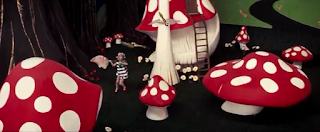May 27th: THE BOY FRIEND (Ken Russell, 1971)
A shy stage manager is forced to play the lead role in a musical when the company's star actress breaks her leg.
After a brief dabbling in dance and photography, Ken Russell began his film career making documentaries of artists for British television, progressively pushing the boundaries of the format over a 10-year period. It took several feature films for Russell to hit his stylistic stride, culminating in his acclaimed adaptation of D.H. Lawrence's Women In Love, which earned him an Academy Award nomination for Best Direction.
Russell's next two films would find him creating even more powerful sensory experiences, including sexual imagery that would garner high controversy. His biopic of Tchaikovsky The Music Lovers was followed by the The Devils, which was censored and edited before release in both the U.S. and Britain. A gentler, more whimsical direction followed with his meta-adaptation of famed stage musical The Boy Friend, originally optioned by MGM for legendary musical producer Arthur Freed (Singin' In The Rain, An American in Paris).
Written by Sandy Wilson in the early 1950s, The Boy Friend paid homage to stage shows of the 1920s, and its initial run was one of the longest in West End history. Russell's conceit was to not only depict the original production's plot, but to have a backstage framing story about a small theatrical company putting on the titular show. To add a third level of a reality, the imaginings of a visiting Hollywood director interested in making a film of the play are presented as big budget Golden Age musical numbers.
In a bold move, Russell cast former model and international style icon Twiggy in the lead role, her only previous screen appearance being an extra in The Devils. Returning collaborators included ballet dancer and actor Christopher Gable, and Glenda Jackson, who had won an Oscar for Women In Love. Broadway actor and dancer Tommy Tune (Hello, Dolly!) also plays a significant role.
Behind the camera, Russell reunited with cinematographer David Watkin and costume designer Shirley Russell, and brought production designer Tony Walton (Fahrenheit 451) onboard. The film was shot at Elstree Studios as well as on location in Portsmouth, Hampshire, including the Theatre Royal, built back in the 1850s.
While more upbeat and fun in tone, the production proved challenging for Russell, who called it the most difficult shoot of his career, the elaborate Busby Berkeley-esque choreography and staging certainly playing a part. The nods toward old Hollywood are joined with colorful flights of fancy reminiscent of the works of Powell & Pressburger (The Red Shoes, Tales Of Hoffmann). Thematically, the film deals with reality vs. illusion, class conflict, and post-war disillusionment.
Not as successful as Russell's previous films, 25 minutes were cut before its American release (for running time issues). It received mostly positive reviews, with Twiggy winning a Golden Globe for Best Actress, and Russell receiving Best Direction honors from the National Board of Review.











Comments
Post a Comment